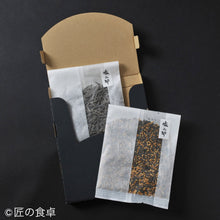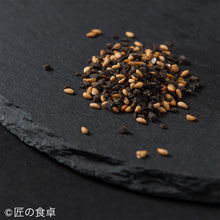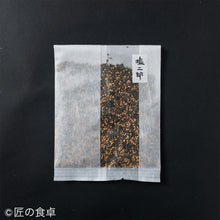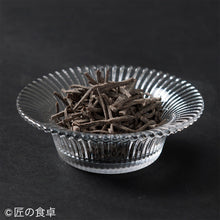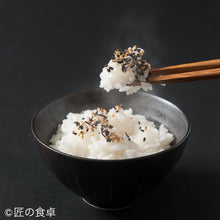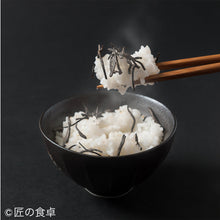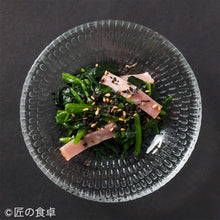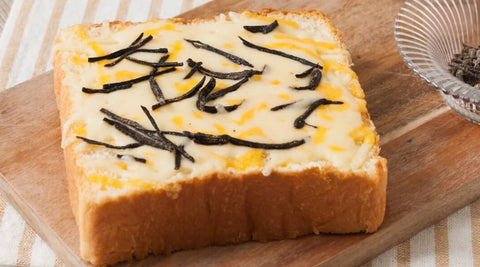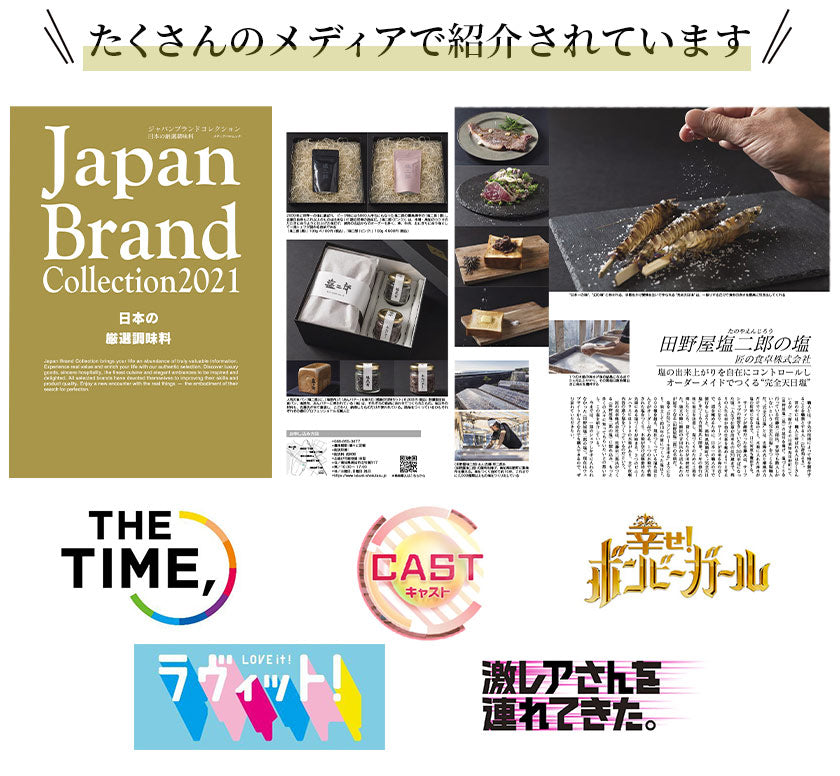Once you try it, you'll be hooked.
The ultimate rice accompaniment

EnjiroTo match the flavor of the salt, we use the rare, highest quality (Grade 1) natural kelp from Hakodate, Hokkaido, which has long been known as the "king of kelp."
First, to bring out the flavor and aroma of the wild konbu, it is aged for three years in a warehouse. Next, after aging, the wild konbu is boiled down in tamari soy sauce, which has a strong umami flavor, and then slowly dried and left to rest for a week. After that, the konbu is cut into pine needle-like shapes and loosened by hand.
After kneading the kelp until it is soft,EnjiroThe salt gently coats the surface of the salted kelp, bringing out the umami and sweetness of the kelp.
It goes well with rice, of course, but it also works well in salads, pasta, stir-fries, and mixed dishes.

This specially made furikake, made with additive-free salted kelp, is also easy to eat. We researched the best size to cut the salted kelp to make it taste the most delicious, and added golden sesame seeds to add a fragrant flavor.
The delicious flavor of kelp and the aroma of golden sesame,EnjiroThe salt perfectly harmonizes the flavor.
This is a product that we would recommend to those who value the natural flavor of ingredients.
It can be enjoyed with rice, or as a condiment for dishes such as boiled greens and cold tofu.
Enjoy the delicious flavor of the finest natural kelp with this set of salted kelp and furikake seasoning.
Recommended for those who don't like the strong or sharp flavors that are typical of additives.
Master of Salt × Master of Kelp

Two craftsmen who were destined to meet.
Salt-making masterEnjiroI first encounteredNaniwa KombuThe president of the company, Mr. Keiichi Kohama, is a master of kelp who is second to none when it comes to talking about kelp and dashi.
"There was a product that I hadn't been able to complete.Enjiro"I thought maybe I could make it if I used Mr. Kohama's salt," said President Kohama. He was surprised when he received the finely powdered salt made especially for salted kelp.
Salted kelp can only be covered with finely powdered salt, not regular salt.EnjiroI suggested, "If you send me your salt, I'll use a grinder to grind it into fine powder and use it," but he replied, "If I use a machine, the taste of the salt will change, so I'll send you the salt that I've ground by hand."Enjiro.
Afterwards, when the finely powdered salt, which had been made entirely by hand, arrived, President Kohama was surprised, saying, "I can't believe it's possible to make such a finely powdered salt by hand?"

The ingredients used to make shio-konbu are salt, konbu, and soy sauce, with no additives whatsoever.
That's why we paid close attention to the materials we used.
We use only the highest grade (Grade 1) of rare natural kelp from southern Hokkaido, which is becoming increasingly difficult to obtain each year.
For soy sauce, use tamari soy sauce, which contains a lot of umami ingredients.
Salt isEnjiroWe used a specially made product made specifically for salted kelp.
First, kelp is cooked in soy sauce, then dried, cut into strips, and loosened by hand.
The salted kelp is then dried further and finally sprinkled with salt to complete the process.
At first glance, the process may seem simple, but we put effort into every step, focusing solely on making the food delicious.
For example, the drying process. Drying at a high temperature will speed up the process, but the disadvantage is that the konbu will become hard. To ensure that the konbu is plump and thick, it is dried at a constant temperature over a long period of time.
It can be served on rice or used as an ingredient in onigiri. It goes well with rice, of course, but it can also be used as a condiment for pasta or stir-fries, or as an ingredient in salads.

The taste of kelp is determined by its place of origin, type, whether it is wild or farmed, and even how it is "aged" after drying.
The kelp is left to rest for 3 to 7 years in a controlled warehouse, and as it matures it is compressed, changing from a deep green to brown and becoming even more fragrant.
In order to make the most of the natural flavor of the ingredients, our artisans use traditional methods that have been passed down through trial and error.
We strive for simple flavors.


Most of the salt sold in Japan is made by boiling seawater that has been mechanically filtered in a cauldron and evaporating it.
EnjiroThis salt is called completely sun-dried salt and is made using only the natural power of sunlight and sea breeze, but there are differences in how sun-dried salt is made.
The most common method is to use a collection tower.
A collection tower is a tower several meters tall with a mesh-like net stretched around the inside.
Seawater pumped up by a pump is sprayed onto the tower, where it falls down through a net and is exposed to the sun and sea breeze as it falls, gradually evaporating. By repeating this process, highly concentrated "brine water" is produced, and most solar salt is made from brine.
EnjiroThere is also a collection tower at the saltworks,EnjiroMost of the time, salt is made without using a salt collection tower.

The reason is that the more steps in salt production are added in order to prioritize efficiency, the more impurities are added and the nutrients contained in the seawater are lost. If you use a salt collection tower, you can make salt in about 1 to 2 months,EnjiroAs you can see, it takes at least three months if you only use sunlight and sea breeze.
Every day, without fail, the seawater contained in the wooden box inside the greenhouse is gently stirred by hand every 1 to 1.5 hours.
It was as gentle as stroking a newborn child.
EnjiroThe salt in seawater andEnjiroThey are obedient children who have been raised with only the love of their parents.
Customer feedback
- I bought this as a gift for my boss. He was very happy with it. Thank you very much.M・Mr. K
Great gift idea


| Product name | 50g salted kelp |
|---|---|
| name | processed kelp products |
| raw materials | Ma kelp (natural, produced in southern Hokkaido), salt (domestically produced), soy sauce (contains wheat and soybeans) |
| Nutrition Facts | Energy (kcal): 168 Protein (g): 15.1 Lipid (g): 0.5 Carbohydrates (g): 39.9 Salt equivalent (g): 18.6 |
| Specific raw materials | Wheat, soybeans |
| Taste Expiration date |
Best-by date 180 days |
| preservation method | At normal temperature |
| Product name | Sesame salted kelp 60g |
|---|---|
| name | processed kelp products |
| raw materials | Ma kelp (natural, produced in southern Hokkaido), salt (domestically produced), soy sauce (contains wheat and soybeans), sesame, yeast extract |
| Nutrition Facts | Energy (kcal): 286 Protein (g): 14.1 Fat (g): 15.1 Carbohydrates (g): 71.7 Salt equivalent (g): 12.6 |
| Specific raw materials | Wheat, soybeans, sesame |
| Taste Expiration date |
Best-by date 180 days |
| preservation method | At normal temperature |
About this product
- *This product will be delivered to your mailbox.
- *We will ship your order two days before the date you specified at the time of purchase.
匠の食卓が選ばれる7つの理由
-
1プロの目利きで選ばれた商品だから
安心の品質 -
2ギフトボックス仕様
※商品により、ギフトボックス仕様ではない場合がございます。 -
3美味しい食べ方レシピ公開中ページはこちら>>
-
4熨斗・メッセージカード対応
※個別メッセージの場合はご注文時にご入力ください。 -
5納品書・明細書・領収書入れません
-
6お届け日指定可能
※受注生産・数量限定品については、ご希望に添えない場合がございます。 -
7
送料込み価格
※お届け先が北海道、沖縄、離島など一部地域のご注文に関しましては別途送料を頂いております。

この商品を使用したレシピ
その他の商品
-
[End of Year Pre-order] Sirloin Steak Set (200g x 2) (Choose from a single steak or a set with salt to go with the meat)
![]()
- 予約販売
- 数量限定
- Regular price
- from 12,600円(税込)
- Sale price
- from 12,600円(税込)
- Regular price
-
- Unit price
- per
Sold out -
【年末予約販売】ローストビーフセット(200g×2個)&タレ(20g×10袋)(単品/肉に合う塩付きセットを選べます)
![]()
- 予約販売
- 数量限定
- Regular price
- from 8,300円(税込)
- Sale price
- from 8,300円(税込)
- Regular price
-
- Unit price
- per
Sold out

![[田野屋塩二郎公式販売サイト]匠の食卓](https://cdn.shopify.com/s/files/1/0509/1200/2215/files/logo.png?v=1618819901)










